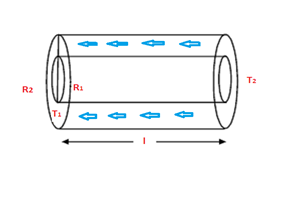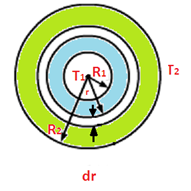A hollow tube has a length ℓ, inner radius R1 and outer radius R2. The material has a thermal conductivity K. Find the heat flowing through the walls of the tube
(a) the flat ends are maintained at temperature T1 and T2(T2> T1)
(b) the inside of the tube is maintained at temperature T1 and the outside is maintained at T2.
Given data-

Length = l
Inner radius = R1
Outer radius = R2
Thermal conductivity = k
The corresponding diagram is shown in the fig.
a. When the flat ends are maintained at temperature T1 and T2(T2> T1)
Now, the area of cross- section through which heat is flowing is given by –
Area,
A = π (R22 – R1 2) (1)
Let q be the heat, then
Rate of flow of heat (H)–
=![]() (2)
(2)
H= ![]()
Where
∆T = is change in temperature between the two walls of the tube.
A= Area of cross section of the tube
K = thermal conductivity of the tube
L = length of the tube
Hence
From (1) and (2),
Rate of flow of heat -
H= k × π(R22 – R1 2) × (T2 - T1)
b. When the inside of the tube is maintained at temperature T1 and the outside is maintained at T2.
Let’s consider a small imaginary
cylinder of radius ”r” of
differential radius “dr” as shown in fig.

Rate of flow of heat (H) –
H = ![]() (1)
(1)
Where
K = thermal conductivity of the tube
A = area of cross section
L = length of the tube
![]() = change in temperature between the two walls of the tube.
= change in temperature between the two walls of the tube.
Negative sign since “r” increases, heat decreases.
Since, the cross-section of the tube is in cylindrical form
Hence Curved Surface Area of the Cylinder,
A =2πrl
Where
r = radius of the base
l = length of the tube
From (1), substituting the value of A,
H= ![]()
⇒
![]() =
= ![]()
Integrating both sides –
⇒ ![]() =
= ![]()
⇒
![]() =
= ![]()
⇒ H = ![]()